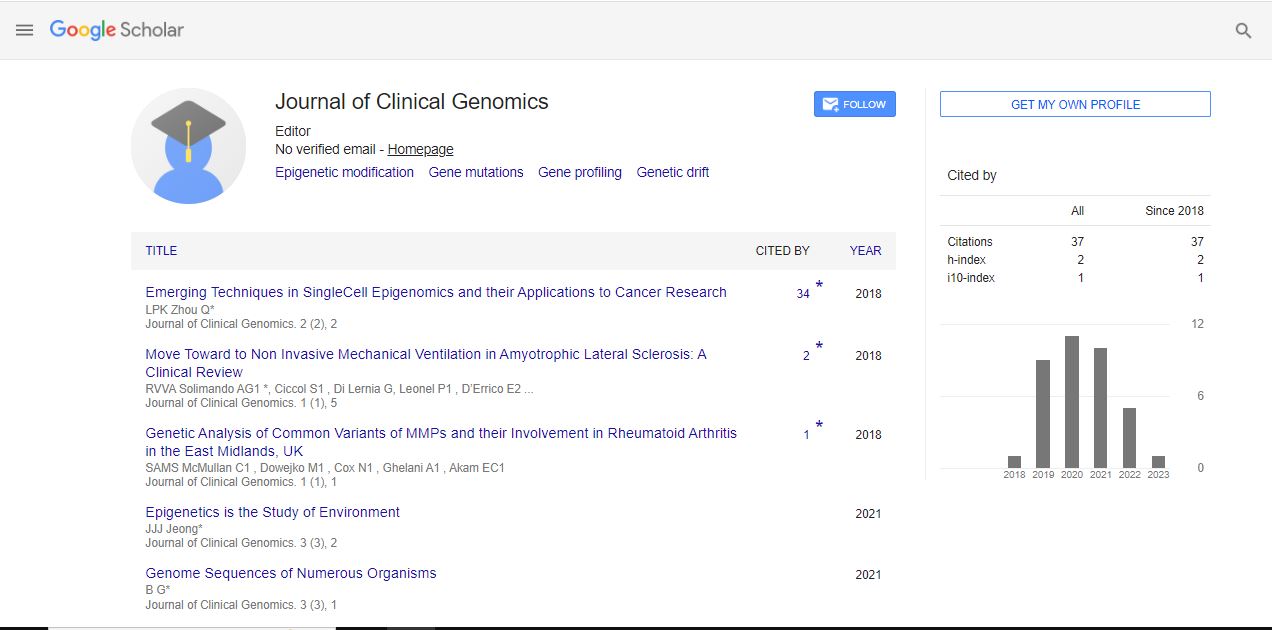Perspective, J Chromatography Res Vol: 6 Issue: 4
Chromatographic Insights into Environmental Quality: Analyzing and Combatting Pollutants
Mike Teixeira*
1Department of Biotechnology, Engineering College of Lorena, University of São Paulo, Lorena, Brazil
*Corresponding Author: Mike Teixeira,
Department of Biotechnology,
Engineering College of Lorena, University of São Paulo, Lorena, Brazil
E-mail: Teixeiramike@gmail.com
Received date: 27 November, 2023, Manuscript No. JCGR-24-123798;
Editor assigned date: 29 November, 2023, Pre QC No. JCGR-24-123798 (PQ);
Reviewed date: 14 December, 2023, QC No. JCGR-24-123798;
Revised date: 21 December, 2023, Manuscript No. JCGR-24-123798 (R);
Published date: 28 December, 2023, DOI: 10.36648/JCGR.1000080.
Citation: Teixeira M (2023) Chromatographic Insights into Environmental Quality: Analyzing and Combatting Pollutants. J Chromatography Res 6:4.
Description
In the realm of environmental monitoring and analytical chemistry, the accurate and sensitive detection of pollutants is paramount for safeguarding ecosystems and human health. Chromatographic methods have emerged as indispensable tools for the analysis of pollutants due to their versatility, precision, and ability to separate complex mixtures. This essay explores various chromatographic techniques employed in the analysis of pollutants, their principles, applications, and the pivotal role they play in environmental monitoring and regulatory compliance.
Chromatography is a collective term for a set of analytical techniques that enable the separation, identification, and quantification of individual components within a complex mixture. The fundamental principle involves the differential partitioning of analytes between a stationary phase and a mobile phase. The diverse nature of pollutants, ranging from organic compounds to inorganic ions, demands a range of chromatographic methods to address specific analytical challenges.
Gas Chromatography (GC) is a widely utilized technique for the analysis of volatile organic compounds (VOCs), which are prevalent pollutants in air, water, and soil. In GC, the sample is vaporized and injected into a chromatograph, where it interacts with a stationary phase (typically a capillary column) and a mobile phase (inert gas). The separation is based on differences in the distribution of analytes between the two phases. GC is commonly employed in environmental monitoring for the analysis of pollutants such as Benzene, Toluene, Ethylbenzene, and Xylene (BTEX), chlorinated solvents, and other volatile organic compounds. Its high sensitivity and selectivity make it suitable for trace-level analysis.
Liquid Chromatography (LC) is a versatile technique that accommodates a broad spectrum of pollutants, including polar and non-volatile compounds. In LC, the sample is dissolved in a liquid mobile phase and passed through a stationary phase, often a packed column or a capillary column. The separation is based on differences in affinity between the analytes and the stationary phase. LC is extensively used for the analysis of various pollutants, including pesticides, herbicides, pharmaceuticals, and heavy metals. It is particularly valuable for polar compounds that may not be amenable to GC analysis. High-Performance Liquid Chromatography (HPLC) and Ultra-High-Performance Liquid Chromatography (UHPLC) variants enhance separation efficiency and reduce analysis time.
Ion Chromatography (IC) is specifically designed for the separation and quantification of inorganic ions. In IC, the sample is injected into a chromatograph equipped with an ion exchange column. The separation is based on the interactions between the ions in the sample and the charged sites on the stationary phase. IC is employed for the analysis of various inorganic pollutants, including common ions such as chloride, nitrate, sulfate, and metals like arsenic and chromium. It is widely used in environmental monitoring, water quality assessment, and compliance testing for regulatory standards.
Solid-Phase Microextraction (SPME) is a sample preparation technique that combines extraction and preconcentration before chromatographic analysis. In SPME, a coated fiber is exposed to the sample, and the analytes partition between the sample matrix and the fiber coating. The fiber is then introduced directly into the chromatograph for desorption and analysis. SPME is particularly useful for the analysis of volatile and semi-volatile organic compounds in air, water, and soil. It is often coupled with GC or GC-MS for enhanced sensitivity and reduced sample preparation steps.
Gas Chromatography-Mass Spectrometry (GC-MS) combines the separation capabilities of GC with the mass analysis capabilities of a mass spectrometer. Following separation in the GC column, the eluted compounds are ionized in the mass spectrometer, and the resulting mass spectra provide information about the molecular structure of the analytes. GC-MS is widely employed for the identification of pollutants due to its capability to provide detailed information about the chemical composition of complex mixtures. It is used in the analysis of a broad range of pollutants, including pesticides, Polycyclic Aromatic Hydrocarbons (PAHs), and volatile organic compounds.
Liquid Chromatography-Mass Spectrometry (LC-MS) combines the separation efficiency of LC with the mass analysis capabilities of a mass spectrometer. LC-MS is suitable for a wide range of analytes, including polar and non-polar compounds, making it a powerful tool for comprehensive analysis. LC-MS is extensively used in environmental analysis for the identification and quantification of pollutants such as pharmaceuticals, personal care products, and emerging contaminants. It is particularly valuable for complex matrices where a diverse range of pollutants may be present.
Chromatographic methods, especially GC and GC-MS, are vital for monitoring air quality and identifying pollutants such as Volatile Organic Compounds (VOCs), ozone-depleting substances, and particulate matter. These analyses aid in assessing compliance with air quality standards and understanding the impact of industrial activities on the atmosphere.
Chromatographic methods, including LC and IC, play a critical role in assessing water quality by analyzing pollutants such as pesticides, herbicides, heavy metals, and organic contaminants. These methods are instrumental in ensuring the safety of drinking water and preserving aquatic ecosystems. Chromatographic techniques are employed in soil analysis to detect and quantify pollutants such as pesticides, Polycyclic Aromatic Hydrocarbons (PAHs), and heavy metals. GC and LC methods are used to assess soil contamination, aiding in remediation efforts and land-use planning. Chromatography is extensively used in the analysis of food and beverages to detect contaminants such as pesticides, mycotoxins, and food additives. LCMS and GC-MS are particularly valuable for ensuring food safety and regulatory compliance.
 Spanish
Spanish  Chinese
Chinese  Russian
Russian  German
German  French
French  Japanese
Japanese  Portuguese
Portuguese  Hindi
Hindi 